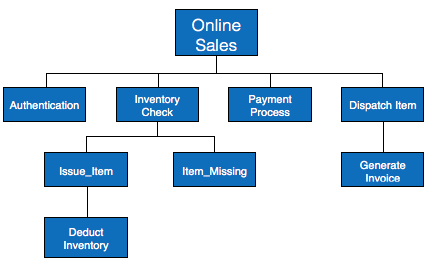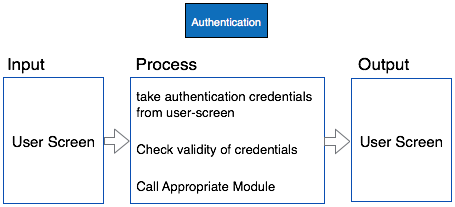HIPO Diagram
HIPO (Hierarchical Input Process Output) diagram is a combination of two organized method to analyze the system and provide the means of documentation. HIPO model was developed by IBM in year 1970.
HIPO diagram represents the hierarchy of modules in the software system. Analyst uses HIPO diagram in order to obtain high-level view of system functions. It decomposes functions into sub-functions in a hierarchical manner. It depicts the functions performed by system.
HIPO diagrams are good for documentation purpose. Their graphical representation makes it easier for designers and managers to get the pictorial idea of the system structure.

In contrast to IPO (Input Process Output) diagram, which depicts the flow of control and data in a module, HIPO does not provide any information about data flow or control flow.

Example
Both parts of HIPO diagram, Hierarchical presentation and IPO Chart are used for structure design of software program as well as documentation of the same.
Structured English
Most programmers are unaware of the large picture of software so they only rely on what their managers tell them to do. It is the responsibility of higher software management to provide accurate information to the programmers to develop accurate yet fast code.
Other forms of methods, which use graphs or diagrams, may are sometimes interpreted differently by different people.
Hence, analysts and designers of the software come up with tools such as Structured English. It is nothing but the description of what is required to code and how to code it. Structured English helps the programmer to write error-free code.
Other form of methods, which use graphs or diagrams, may are sometimes interpreted differently by different people. Here, both Structured English and Pseudo-Code tries to mitigate that understanding gap.
Structured English is the It uses plain English words in structured programming paradigm. It is not the ultimate code but a kind of description what is required to code and how to code it. The following are some tokens of structured programming.
IF-THEN-ELSE,
DO-WHILE-UNTIL
Analyst uses the same variable and data name, which are stored in Data Dictionary, making it much simpler to write and understand the code.
Example
We take the same example of Customer Authentication in the online shopping environment. This procedure to authenticate customer can be written in Structured English as:
Enter Customer_Name
SEEK Customer_Name in Customer_Name_DB file
IF Customer_Name found THEN
Call procedure USER_PASSWORD_AUTHENTICATE()
ELSE
PRINT error message
Call procedure NEW_CUSTOMER_REQUEST()
ENDIF
The code written in Structured English is more like day-to-day spoken English. It can not be implemented directly as a code of software. Structured English is independent of programming language.
Pseudo-Code
Pseudo code is written more close to programming language. It may be considered as augmented programming language, full of comments and descriptions.
Pseudo code avoids variable declaration but they are written using some actual programming language’s constructs, like C, Fortran, Pascal etc.
Pseudo code contains more programming details than Structured English. It provides a method to perform the task, as if a computer is executing the code.
Example
Program to print Fibonacci up to n numbers.
void function Fibonacci
Get value of n;
Set value of a to 1;
Set value of b to 1;
Initialize I to 0
for (i=0; i< n; i++)
{
if a greater than b
{
Increase b by a;
Print b;
}
else if b greater than a
{
increase a by b;
print a;
}
}




No comments:
Post a Comment